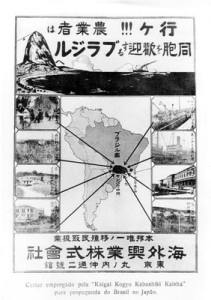
Early 1900s propaganda poster encouraging Japanese immigration. Image courtesy of the Brazilian government.
Like the U.S. and Canada, Brazil has a long history of welcoming immigrants from all over the world. In fact, Brazil was built by immigrants – from Portugal and Africa during colonial times, followed by Italy, Germany, Spain and other Europeans in the 19th and early 20th centuries as well as Japanese, Lebanese and Syrians, and more recently migrants from South American neighbors such as Bolivia.Five centuries of immigration have shaped Brazilian society and culture into one of the richest and most diverse on the planet. Bahia’s capital of Salvador, for example, is the city with the second largest population of African descent after Lagos. São Paulo – 60 percent of whose population can claim some Italian ancestry – is a city where the pizza rivals that munched upon in Rome (this according to Italians). Brazil also boasts the largest Japanese and Lebanese communities outside of their respective countries.
In recent decades, immigration to Brazil all but ground to a halt due to the political and economic turbulence that plagued the nation during much of the late 20th century. As a result, today foreigners represent a mere 1 percent of Brazil’s workforce, down from 7 percent at the turn of the 20th century. In other terms, the number of immigrants in Brazil in 2012 is half of what it was 100 years ago when the population was ten times smaller.
According to the most recent Brazilian Census carried out by the Instituto Brasileiro de Geografia e Estatística (IBGE), between 2000 and 2010, the number of immigrants living in Brazil increased by 87 percent.This trend has begun to change as a result of Brazil’s growing economy coupled with a severe lack of skilled workers and the economic crises wreaking havoc (and unemployment) in the United States and Europe. Between 2006 and 2011, the number of work permits granted to foreign professionals tripled from 25,400 to 70,524, and between 2010 and 2011, this number rose by 32 percent. China, which is currently Brazil’s leading trade partner and main foreign investor, was the largest source of work visas, followed by the United States, Portugal, France, and Spain.Moreover, in 2011, Brazil reprised its traditional role as a recipient country; for the first time in two decades the number of foreign immigrants entering Brazil was larger than the number of Brazilians leaving the country. Between 2010 and 2011 alone, the number of foreign-born residents increased by 50 percent. By the end of 2011, there were 2 million foreign nationals living legally in Brazil – and an estimated 600,000 undocumented foreigners (which is still miniscule when compared to neighboring Argentina, where legal foreign residents represent 14 percent of the population – and the United States, where they account for 13 percent.)
According to the most recent Brazilian Census carried out by the Instituto Brasileiro de Geografia e Estatística (IBGE), between 2000 and 2010, the number of immigrants living in Brazil increased by 87 percent. And somewhat to my surprise, in 2010, the largest source of foreign immigrants was none other than the United States.
The almost 52,000 Americans who immigrated to Brazil that year represented a major increase from 2000, when only 16,695 Americans moved to Brazil. Like the majority of these new immigrants, most Americans who come to Brazil are skilled professionals lured by the many opportunities in areas such as finance, engineering, oil and gas, mining, and IT. The Brazilian states that draw the greatest number of newcomers are those whose economies are experiencing the biggest booms: São Paulo, Paraná, Minas Gerais, Rio de Janeiro, and Goiás.
It looks like this new wave isn’t likely to subside anytime soon. In fact, this week the Brazilian government announced that it was committed to attracting up to 10 times as many foreign professionals to ensure the continued expansion of the Brazilian economy. In order to achieve this goal, it is considering passing legislation that eases the immigration process, which is great news since, like most processes in Brazil, obtaining any kind of long-term visa for Brazil can be notoriously, and maddeningly, bureaucratic.